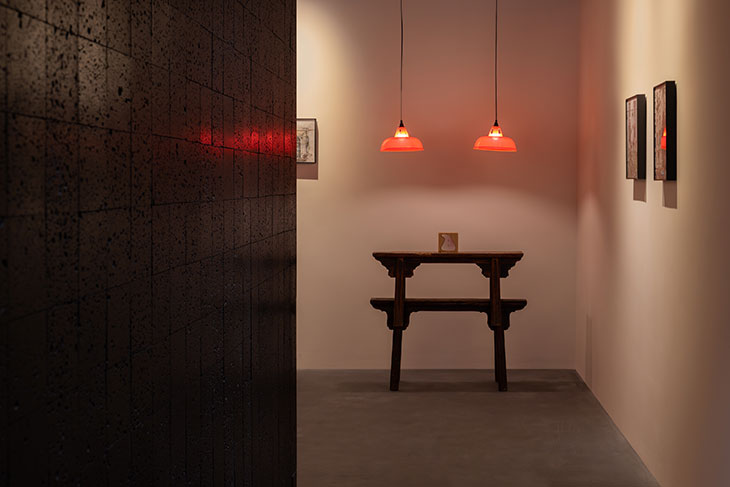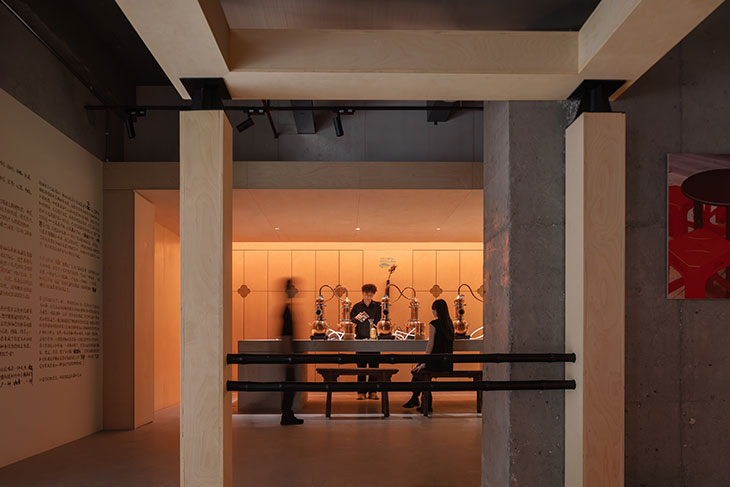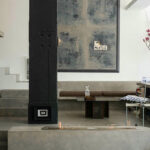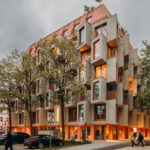
Established in 2010 at Shantou University and officially launched in Guangzhou in 2013, One Fine Day Studio & Partners has carved a niche in Visual Design, Interior Design, Art Installation, and Brand Integration. The studio champions design differentiation, exploring the unique DNA of brands to address their individual and systematic communication challenges. With a versatile approach across various media, they aim to forge the most effective connections between brands and consumers, exploring the intersection of consumer fashion and brand strategy to open up new avenues for brand building and promotion.
INTERVIEWS
In this interview by our Editor Anastasija Pavic, Junpeng shares insights into their design process for CHATBY, a project that combines storytelling, memory, and traditional cultural elements with contemporary commercial space. Drawing inspiration from the ancestral halls of the Lingnan region, they have crafted a “contemporary ancestral hall” that fosters community and connection while maintaining a versatile and adaptable environment. By pushing the “wall” facing the street inward by 3 meters to create a connecting corridor, they weakened the rigid rules of the modern concrete city, allowing for a spatial ideal that merges exhibitions, dining, and gin-making experiences.
Прикажи ову објаву у апликацији Instagram
How did you integrate the concept of storytelling and memory into the design of CHATBY?
In the past, when communication networks were less developed, people liked to gather in comfortable and convenient venues for daily social activities and collective community behaviors. Ancestral halls (a place for worshiping ancestors and passing on family history and spirit) served as important gathering places for the community. Inspired by the traditional ancestral halls in the Lingnan region, we incorporated core elements of these halls into modern spaces, creating a new form of commercial space that we call the “contemporary ancestral hall.”
In terms of branding: The project’s name initially started with the word “neighbor.” The brand name reflects the owner’s expectation that surrounding residents and neighbors would come and gather here. During the co-creation process, we added the word “narrate” to the concept of “Lin Li,” hoping that people could gather and share stories here.

What were the main difficulties in enhancing light and space in the semi-detached house?
The first challenge was creating a suitable entrance for the space. Since the exterior of the space is the entrance and exit of a parking lot driveway, we avoided placing the entrance in the center of the space to prevent guests from dining facing the driveway. We also considered the need for an open corridor as a transitional semi-outdoor space, so we created two entrances on the left and right sides, making the middle more spacious. This design ensures that enough outdoor light flows into the interior, creating a relaxing environment, while adding greenery to the right side to maintain privacy while allowing light to enter.
How did you decide on the materials and color palette?
We chose warm tones like red for lighting and materials to create a dining atmosphere, and retained the original state of the cement to maintain a relaxed atmosphere in the space. We also aimed to create a sense of time and differentiate the space from many contemporary styles that follow a “light and fresh” aesthetic. This decision aligns with the traditional wood furniture of the Lingnan region, which tends to develop a reddish hue over time. Additionally, we applied dark protective coatings to the bamboo to echo traditional furniture like the “Eight Immortals Table.”

Could you explain the significance of the promenade as an “in-between” space?
When we first saw the space, we thought of setting it back about 3 meters to create a semi-outdoor area, reminiscent of our old homes in Chaoshan, with corridors and courtyards. It also resembles the open spaces in schools. We wanted to ensure that this space would not be isolated from the surrounding community by glass and walls.

How does the integration of traditional and contemporary design elements, contribute to the space’s identity?
We have shaped the space’s uniqueness through spatial design and brand visual design, thereby enhancing its identity. For example, we created a pavilion in the center of the dining hall, similar to the pavilions found in many parks and communities. This design makes guests feel as though they are entering a courtyard after passing through the corridor. The pavilion provides a sense of shelter and security during dining, with a touch of subtlety and intimacy. Although many interior spaces avoid having too many columns, we intentionally used them to enhance the guests’ sense of security. The pavilion is centered around a large lantern, a traditional element used in many regions. We used black bamboo, which resonates with the space, to create a unique expression, fostering a comfortable and approachable atmosphere. The brand’s visual elements are also presented through burlap embroidery.
In what ways does CHATBY foster a sense of community and belonging among its visitors?
The open corridor offers residents more opportunities to encounter us, and visitors can choose to dine, drink, and socialize in the semi-outdoor area that is closer to the community. The exhibition area in the roommate’s window and the gin teaching area increase the interaction between Lin Li Xu / CHATBY and the visitors.

How do you ensure that the space remains versatile and adaptable for various types of gatherings and events?
The space features private rooms with folding doors that can be opened or fully partitioned, making it suitable for events or gatherings that require a certain level of privacy or need to avoid interference. The dining area in the center of the space connects to the gin area and bar through the new-style pavilion we created. The flexible furniture allows these areas to be linked together to form a large venue, making it more convenient for hosting large, public events.

What role does the local Chaoshan culture play in the design, and how do the visual elements reflect this cultural heritage?
Chaoshan culture is a significant intersection of Lin Li Xu / CHATBY’s cuisine, team composition, and local community. Therefore, we have integrated Chaoshan elements into every detail to convey and perpetuate the rich cultural heritage of the Chaoshan region. For example, we used traditional wood carvings to decorate the walls in the corridor area and innovated traditional bamboo chairs into black bamboo chairs that better fit the space. The brand’s logo and visual elements were inspired by the old generation’s favorite palm fans in the Lingnan region, with the fan handle extending into a series of images incorporated into the space’s details. These design elements work together to create a space filled with the atmosphere of Chaoshan culture, allowing visitors to experience the unique charm and historical legacy of Chaoshan culture through visual and tactile means. This cultural experience not only enhances the space’s identity but also promotes understanding and dissemination of Chaoshan culture.

How do you envision the evolution of CHATBY in the context of its neighborhood?
We see ourselves as founders of a modern ancestral hall. Through design and the operation of the Lin Li Xu / CHATBY team, we hope to help local residents, and even visitors from other places, discover and return to the community. The next phase of evolution will be left to our guests.



